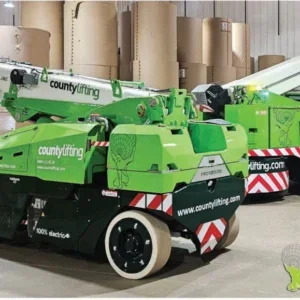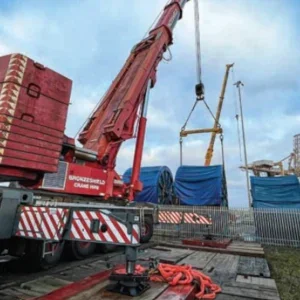The best time to troubleshoot wire rope problems is while it is operating on the equipment. Unfortunately, due to the importance of keeping equipment running, the wire rope may be taken out of service before a wire rope engineer has the opportunity to examine it. The sample is then sent back to the wire rope manufacturer for cause determination. This article outlines the approach that one manufacturer of wire rope takes with these returned samples as well as troubleshooting on site. The lessons learned from these examinations should help prevent recurring problems as well as provide the answer to some puzzling wire rope reactions.
The inquest
Much like a medical examiner or coroner, the director of engineering is called upon to perform an autopsy on a wire rope returned from the field. When a sample is sent in, the sender usually believes that there was some kind of “birth defect”. Oddly enough, it is the director of engineering that issued the birth certificate (test certificate) and is now responsible for determining the cause of death.
The most important thing to receive with the rope sample is proper documentation. Rope samples are often received with no paperwork, which delays the examination. Along with the rope sample, the following information should be supplied:
• rope description (diameter, construction and reel number)
• rope application and type, and manufacturer of operating equipment
• previous rope history – service lives and usual reasons for rope retirement
• changes – this would include changes in type of work; change in rope manufacturer or construction; equipment modifications, operator, lubrication etc.
• copy of inspection reports covering the sample in question.
As a rule, examinations are not performed on ropes from other manufacturers. Yet many ropes are received that were made elsewhere. Generally, this is not because of misrepresentation during the supply phase, but because of poor record keeping. It is recommended to use a wire rope inspection log where the user can enter the appropriate wire rope information along with the installation date. The wire rope manufacturer’s test certificate should also be stored with the inspection log. The inspection information that is recorded on the log is extremely valuable as the user can also monitor the rate of deterioration.
In one incident a user had experienced a total boom hoist rope failure. Samples of the rope were sent back and it was quickly determined that it was made by another manufacturer. The user was surprised because it had not bought a rope from that manufacturer for over three years. The company policy was to change boom hoist ropes at least every two years. Failure occurred because the rope was way beyond normal retirement criteria. This could have been picked up from an inspection form and the accident thus prevented. Of course, proper inspection techniques would have also prevented the failure.
The first part of the examination is to verify the rope construction. The manufacturer is not verified until the rope is disassembled so the marker can be obtained. The diameter is taken and compared to the diameter recorded at manufacture. The rope’s lay length is also measured and compared to the original measurement. The rope’s exterior surface is examined for wear and corrosion. If broken wires are present, they are counted and the type and location of fracture is noted and recorded.
Sometimes there may be deformation in the rope structure. This could be localised kinks, severe wire displacement or possibly a corkscrew or wave. If the latter condition is noted, the amplitude of the deformation and length of affected area is recorded. The rope is also examined for thermal damage. The rope is then disassembled and the internal rope is inspected much like the rope’s exterior, except that the degree of wire indentations (notching) is also examined.
All the findings are like clues that when put together with the background information determine the cause of failure. Many of the samples received have completely failed and should have been removed from service long before the time of failure. It is evident that they were not inspected thoroughly or in a timely manner. Other failures happened suddenly, like a jumped sheave or from a shock load. These are not inspection problems but either machine or operator related. These latter examples usually arrive in a condition that makes it obvious what has happened.
An example of this is shown in Figure 1 which shows a rope that has operated around an extremely small radius, perhaps from jumping a sheave. Operating around such a small radius has caused this coil like condition.
Figure 2 is an example of a rotation resistant rope from a pedestal crane that has experienced a shock load, resulting in the inner rope popping out suddenly.
Sometimes, a wire rope failure has to be investigated at the scene. Figure 3 shows a wire rope that has completely failed. On closer examination, the majority of the wire ends were cut in shear with some broken in tension. The fact that most of the wire fractures were in shear indicates that a sharp object had severed the rope.
Upon closer investigation, the sheave shown in Figure 4 appears to be the murder weapon. The rope evidently looped out of the sheaves somehow and when put back under tension straddled the sheave and was cut by the sharp edge.
The house call
If the rope is still operating on the equipment there is an opportunity to see the rope problem and how it relates to its environment. When troubleshooting in-situ, no assumptions are made. Essentially, some basic steps are followed that should provide all the information needed to make a cause determination.
The following steps should be followed:
• rope identification – verify rope construction, manufacturer and reel number
• breaking strength verification – check manufacturer’s test certificate
• verify applicable code for retirement criteria and design factors
• review inspection history – this provides a basis for expected rope life and usual mode of failure (reason for removal)
• inspect the suspect area
• inspect the complete rope
• check the condition of the rope related equipment: drum – general condition drum grooves – radius and pitch kicker plates or wear plates – condition and position sheave grooving – correct shape and size sheaves – free to rotate and in good condition rope guards – correctly fitted and in good condition wear plates or rollers – condition
• make sure the complete rope path is checked and/or any device or item that contacts the rope through its working cycle (including alignment)
• review the method of rope installation.
A simple trick is to paint the damaged area and see where the affected area is positioned during the operating cycle. Figure 5 is an example of a rope that was at the flange in the layer change transition point. The rope should have been retired before it made it to this condition. A simple drum end rope cut earlier in the rope life would have moved the rope before it became a problem. Slip and cut programmes extend rope life and should be considered for all drum applications (especially smooth face drums). Information gathered should determine the cause of the problem. The most common problems are:
• misapplication
• wrong wire rope construction, diameter and/or grade used
• general misuse and abuse
• shock load/overload
• forklift damage from handling the reel
• poor drum spooling (plain face drum)
• insufficiently sized sheaves/drums
• insufficient tensioning of rope during installation
• induced turn during installation
• lack of in service lubrication
• machine condition/alignment.
Before contacting the manufacturer, review publications like the Wire Rope Users Manual published by the USA’s Wire Rope Technical Board. Samples of various problems are illustrated which can help the user make an immediate determination. If the cause cannot be identified, take down all the information as covered earlier and ask the original manufacturer for assistance. No matter what has happened to the wire rope, it leaves behind undeniable clues that when matched with site information provides the investigator with the answer to the problem. Wire rope always tells the story.






